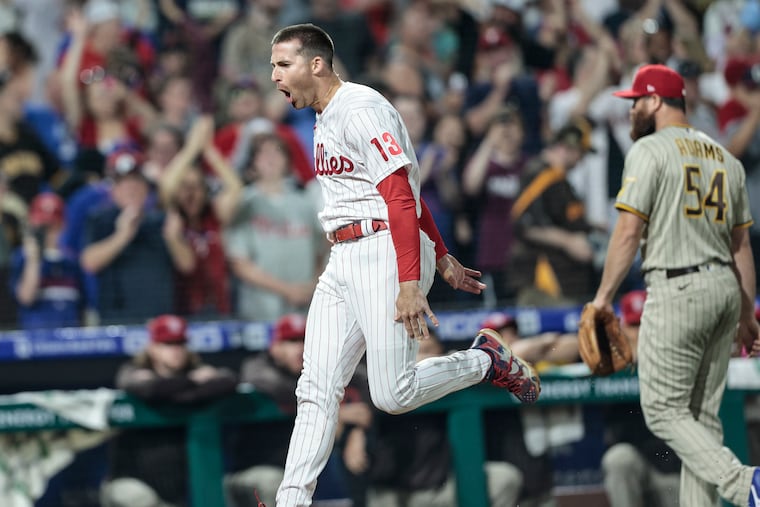Brad Miller and the Phillies’ reserves were the team’s greatest strength during the first half | Bob Brookover
The Phillies remained in the NL East race during the first half of the season and for that they should thank their bench players.

Carefully examine the Phillies’ first half of the 2021 season and it would still be difficult to find their greatest strength.
Even with their late surge of offense, they still rank 13th among 30 teams in runs per game. That’s pretty much the middle of the pack. And even with Zack Wheeler sitting near the top of baseball’s list of aces, the starting rotation’s 4.15 ERA is no better than 15th. That’s exactly the middle of the pack.
If only the bullpen were in the middle of the pack, too. It is not. It is the team’s greatest weakness for the second straight season. Take away six of the team’s major league-leading 22 blown saves and the Phillies would likely be sitting in first place as they wait for the season to resume Friday with a doubleheader against the Miami Marlins.
Instead, they are 3½ games behind the first-place New York Mets.
So, you’re probably still wondering, what exactly does this team do well?
It perseveres, and for that the Phillies can thank their reserves. If you’re going to have a conversation about the best benches in the National League, the Phillies deserve to be in it.
Up in New York, the Mets are fiercely proud of what their bench did during the first half. With starters Jeff McNeil, J.D. Davis, Brandon Nimmo, and Michael Conforto sidelined for long stretches, the Mets got terrific contributions from Jonathan Villar, Billy McKinney, Kevin Pillar, Luis Guillorme, and Jose Peraza. It could also be argued that their backup catcher, Tomas Nido, played better than their starter, James McCann, who signed a four-year deal worth $40.6 million before the season.
The Mets’ reserves played so well that they even earned a nickname: The Bench Mob. The six Mets bench players listed above combined to hit .232 with 31 home runs and 87 RBIs in 785 at-bats. Four of the six had an OPS higher than .700 and all six had an OPS of .645 or higher. That’s impressive.
The Phillies did not have to use their reserves quite as often as the Mets, but injuries to Didi Gregorius, Jean Segura, Bryce Harper, and J.T. Realmuto did test the team’s depth. Thanks to the cast of Brad Miller, Ronald Torreyes, Nick Maton, Luke Williams, Travis Jankowski, and Andrew Knapp, the Phillies managed to remain in the NL East race.
The Phillies’ top six bench players combined to hit .251 with 18 home runs and 76 RBIs in 589 at-bats. Five of their top six bench players had an OPS above .700, with Miller and his nine home runs leading the way at .802.
Atlanta’s bench was also tested in the first half, thanks to injuries to catcher Travis d’Arnaud and Marcell Ozuna, and it will face an even greater challenge after the season-ending injury to superstar Ronald Acuna Jr. last weekend. The Braves’ top six bench players hit just .204 with 13 homers and 64 RBIs in 487 at-bats during the first half.
Washington, despite a strong adjustment to a bench role by Ryan Zimmerman, also lacks depth and the Marlins probably have the worst bench in the league.
There are a lot of reasons the San Francisco Giants are the most improved team in baseball this season, and the fact that they have the best bench in the league is among them. Manager Gabe Kapler has three bench players with nine home runs, including Darin Ruf, who has a .399 on-base percentage and a .959 OPS.
Milwaukee and Cincinnati, the top two teams in the NL Central, have also received terrific bench production.
» READ MORE: How the Phillies drafted a player most teams never heard of and other draft observations
A lot of people can take credit for the Phillies’ improved bench play. Team president Dave Dombrowski’s decision to bring back Miller on a free-agent deal has obviously been a good one. Dombrowski also did well to sign Jankowski to a minor-league deal right before the start of spring training.
Joe Girardi gets the credit for Torreyes, who played for the Phillies manager when they were both with the Yankees.
Williams and Maton, meanwhile, are draft picks who could become valuable pieces in the Phillies’ future because they can both play multiple positions and have high baseball IQs. They are the type of players the Phillies thought they had in Scott Kingery when they signed him to a six-year deal worth $24 million just before the start of the 2018 season. Williams was a third-round pick in 2015, the year the Phillies took Kingery second. Maton was a seventh-round pick in 2017 and he has a chance to become the team’s best selection from that draft class.
The bench, to be sure, is not the most stirring strength a team can have. Bench Mob, after all, is a pretty weak nickname. But if you want to earn one of the golden tickets to the postseason, it sure helps to have some quality players in reserve.